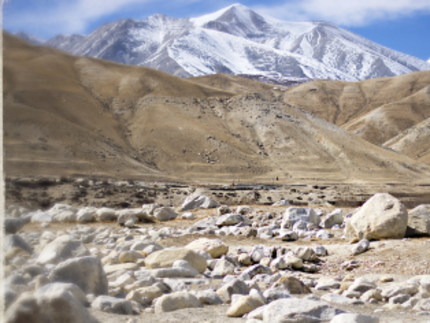Hazard from Himalayan glacier lake outburst floods
Funding agency:
Deutsche Forschungsgemeinschaft (DFG)
Research Training Group NatRiskChange - Project I4
Funding period:
10/2015 - 09/2018
Project description:
A disproportionate increase in population in mountainous regions worldwide currently coincides with climate-accelerated rates of natural hazards. Glacial lake outburst floods (GLOFs) are an example for such a hazard. GLOFs are a special case of flooding that results from sudden release of meltwater ponded behind natural dams, and their connection to climate change are intensely debated. Glacial meltwater lakes occupy the highest parts of a mountain range, so their potential energy can be transformed to hazardous and highly destructive flows. The combined effects of increased human exposure (and thus vulnerability) and climate change on GLOF hazards and the corre-sponding changes to hazards and risk are subject of this proposal. Although satellite-based remote sensing is an efficient analysis and monitoring tool, remaining uncertainties are substantial because of the complexity of the involved processes and the limited temporal repeat rate of data acquisitions. The same holds for damage potential from an increase in development as well as urbanization of mountain areas. Additional uncertainty pertains to GLOFs that are reconstructed from remotely-sensed data and to future GLOFs projected from corresponding climate simulations.
Main results
- We developed a robust algorithm to detect automatically Glacial Lake Outburst Floods (GLOFs) in the Himalayas and adjacent mountain belts from a time series of Landsat images. With this method we generated the first systematic GLOF inventory for the region from 1988-2017.
- The method was able to more than double the existing GLOF count in the greater Himalayan region, and identified the southern Himalayas (mainly of Nepal and Bhutan) as a hotspot of GLOF activity in the past 30 years. Both overall and regional GLOF frequencies remained unchanged in this period despite ongoing glacier melt and growth of meltwater lakes in most of the study area.
- We proposed a first objective GLOF hazard appraisal for existing and projected future meltwater lakes in the Himalayan region. Estimates of the 100-year GLOF discharge assign the highest contemporary GLOF hazard to the southern Himalayas, consistent with the highest GLOF rate in the past three decades in that region.
Cooperation partner:
- Dr. Sigrid Roessner, GFZ German Research Centre for Geosciences
Project-related publications
- Veh, G., O. Korup, S., and A. Walz (2020). Hazard from Himalayan glacier lake outburst floods. PNAS, 117, 2, 907-912.
- Veh, G. (2019): Outburst floods from moraine-dammed lakes in the Himalayas: Detection, frequency, and hazard. Doctoral thesis, University of Potsdam, https://publishup.uni-potsdam.de/43607.
- Veh, G., O. Korup, S., von Specht, S. Roessner, and A. Walz (2019). Unchanged frequency of moraine-dammed glacial lake outburst floods in the Himalaya. Nature Climate Change, 9, 379-383, dx.doi.org/10.1038/s41558-019-0437-5.
- Veh, G., O. Korup, S. Roessner, A. Walz (2018). Detecting Himalayan Glacial Lake Outburst Floods from Landsat time series. Remote Sensing of Environment, 207, 84-97.
Project webpages
Research training school NatRiskChange: www.natriskchange.de
PhD project I4: Changing risks from glacial lake outburst floods

